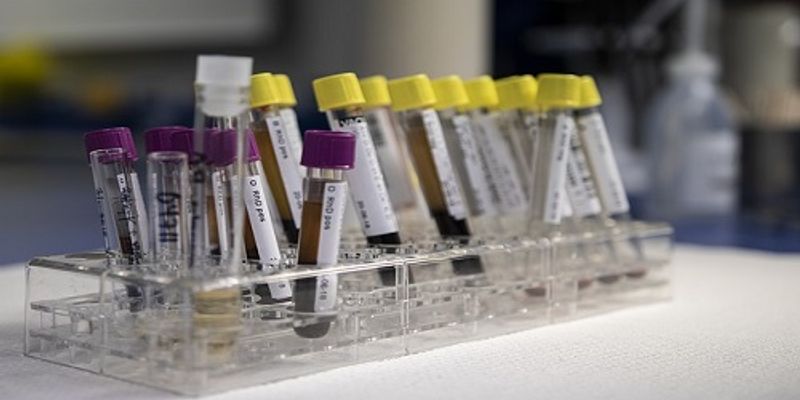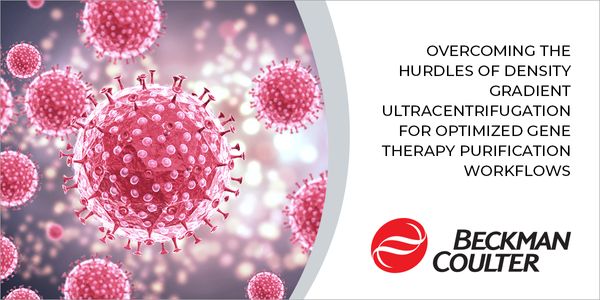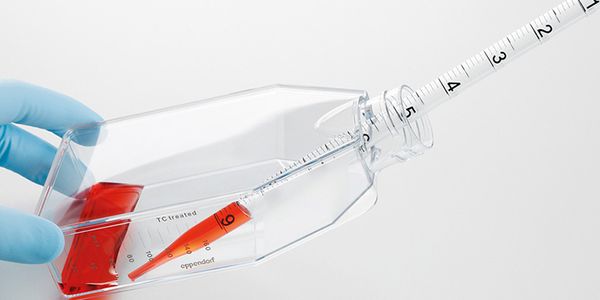Protein Isolation
Protein Isolation: The initial step in protein isolation from its source is to physically or chemically disrupt the biological tissue or organism in order to release the protein into the extract. In some cases, the organism secretes the protein, and cell disruption is unnecessary. The protein is usually produced in dilute concentration so it is advantageous if the initial isolation also results in the concentration of the protein. An important feature in any isolation procedure is product yield with the goal being to extract as much of the desired protein as possible in a minimum amount of time.
-
AUG 06, 2020 | 10:00 AMNatural light-harvesting systems, such as photosynthetic pigment-protein complexes, efficiently transfer energy through space with high efficiency. Ultimately, we would like to understand th...JUL 22, 2020 | 10:00 AMDATE: July 23, 2020 TIME: 10:00 am PDT The SARS-CoV-2 pandemic has taken a toll on many sectors of the medical community. As the pandemic took a grip on the laboratory, the need for diagnost...JUN 17, 2020 | 12:00 PMThe 2020 pandemic caused by the severe acute respiratory syndrome coronavirus 2 (SARS-CoV-2) continues to rage. While PCR-based assays are used for viral diagnosis, high through-put, rapid s...Speaker: Susan Zolla-Pazner, PhDJUN 03, 2020 | 12:00 PMA key step in the clinical production of CAR T cells is the expansion of engineered T cells. To generate enough cells for viable adoptive cell therapy, cells must be robustly stimulated, whi...Speaker: Pratip K. ChattopadhyayJUN 02, 2020 | 9:00 AMDATE: June 2, 2020 TIME: 9:00am PT, 12:00pm ET Osmolality is a well-established parameter for upstream bioprocessing, formulation, analytical development and QC applications throughout the m...MAY 20, 2020 | 12:00 AMTechniques to analyze and sort single cells based on secreted products have the potential to transform our understanding of cellular biology as well as accelerate the development of next gen...Speaker: Joseph de RutteMAY 19, 2020 | 11:15 AMWe applied CITE-Seq to measure >150 cell surface immune markers and checkpoint proteins simultaneous to RNA-Sequencing. We resolve the tumour-immune milieu with high precision and reveal...MAY 06, 2020 | 1:00 PMThe forensic investigation of crime involves answering four basic questions: who, what, where, and when. Tools exist to answer questions of who, what and where, but the question when is ofte...MAY 06, 2020 | 9:00 AMCrime scene investigation is more than just processing or documentation of crime scenes, nor is it just the collection or packaging of physical evidence. It is the first step and the most cr...MAY 06, 2020 | 7:30 AMThe toxicology of particulate matter is complicated by characteristics not normally encountered when addressing poisonings associated with chemical substances. Particle shape, surface reacti...MAY 06, 2020 | 12:00 AMThe potential for cognitive bias in forensic evidence interpretation and crime scene investigation continues to receive attention and debate within forensic and academic communities. Startin...MAY 06, 2020 | 12:00 AMLearning Objectives: 1. Molecular basis of microhaplotypes 2. Informativeness and power of discrimination of microhaplotypes 3. Mixture deconvolution via microhaplotypes...MAY 06, 2020 | 12:00 AMIn late 2019, nearly a decade into a life sentence, Lydell Grant was released from a Texas prison after being convicted of a murder that he did not commit. The victim, Aaron Scheerhorn, was...MAY 06, 2020 | 12:00 AMThe current standard methodology in forensic DNA typing relies on amplification of short tandem repeat (STR) markers by the polymerase chain reaction (PCR) and allele sizes (i.e., length-bas...MAY 06, 2020 | 12:00 AMHydroxychloroquine and chloroquine are long-standing antimalarial drugs recently brought into the spotlight as potential treatments for the pandemic-causing coronavirus (SARS-CoV-2). Notable...MAY 06, 2020 | 12:00 AMThe ever-increasing number of deaths along the U.S.-México border and the diversification in the demographic characteristics of the Latin American migrants, who perish in this region,...MAY 06, 2020 | 12:00 AMThe necrobiome is the community of organisms that use or are affected by decomposing organic matter. Decomposing organic matter comes in the form of dead plant matter (biomass) or that of de...FEB 26, 2020 | 1:30 PMWhether you are performing killing assays, characterizing the tumor microenvironment, or investigating immunogenicity, primary cells are essential for the discovery of new therapeutics. Conc...Speaker: Josh Mahlios, PhDJAN 29, 2020 | 9:00 AMDATE: January 29, 2019 TIME: 9:00am PST Plasma membrane proteins are a difficult subset of proteins to solubilize, purify, quantify, and detect, largely due to the challenge of extracting th...JAN 01, 2020 | 6:00 AMThe use of primary cells in vitro is compromised by the limited quantity of cells that can be isolated from one donor, a lack of or very restricted proliferation capacity (e.g. hepatocytes)...Speaker: Astrid Nörenberg, PhDPresented at: Drug Discovery & Development Virtual Event Series 2020
JAN 01, 2020 | 6:00 AMThe liver plays a critical role in the metabolism and clearance of more than 70% of marketed drugs. Furthermore, toxicity to the liver is a major reason for preclinical and clinical drug fai...DEC 04, 2019 | 7:00 AMDATE: December 4, 2019TIME: 7:00am PST, 10:00am EST, 4:00pm CET Do you know how it feels when you just quickly want to redo an experiment that your colleague did, or an experim...NOV 19, 2019 | 8:00 AMDATE: November 19, 2019TIME: 8:00am PTCentrifugation has long served as a critical separation tool in countless research and production facilities spanning a wide range of discipline...NOV 18, 2019 | 7:00 AMDATE: November 18, 2019TIME: 7:00am PST, 11:00am EST, 4:00pm CEWT How often do you pipette in your cell culture lab every day? Usually, we do it so often that we tend stop th...
AUG 06, 2020 | 10:00 AM
Natural light-harvesting systems, such as photosynthetic pigment-protein complexes, efficiently transfer energy through space with high efficiency. Ultimately, we would like to understand th...
JUL 22, 2020 | 10:00 AM
DATE: July 23, 2020 TIME: 10:00 am PDT The SARS-CoV-2 pandemic has taken a toll on many sectors of the medical community. As the pandemic took a grip on the laboratory, the need for diagnost...
JUN 17, 2020 | 12:00 PM
The 2020 pandemic caused by the severe acute respiratory syndrome coronavirus 2 (SARS-CoV-2) continues to rage. While PCR-based assays are used for viral diagnosis, high through-put, rapid s...
Speaker:
Susan Zolla-Pazner, PhD
JUN 03, 2020 | 12:00 PM
A key step in the clinical production of CAR T cells is the expansion of engineered T cells. To generate enough cells for viable adoptive cell therapy, cells must be robustly stimulated, whi...
Speaker:
Pratip K. Chattopadhyay
JUN 02, 2020 | 9:00 AM
DATE: June 2, 2020 TIME: 9:00am PT, 12:00pm ET Osmolality is a well-established parameter for upstream bioprocessing, formulation, analytical development and QC applications throughout the m...
MAY 20, 2020 | 12:00 AM
Techniques to analyze and sort single cells based on secreted products have the potential to transform our understanding of cellular biology as well as accelerate the development of next gen...
Speaker:
Joseph de Rutte
MAY 19, 2020 | 11:15 AM
We applied CITE-Seq to measure >150 cell surface immune markers and checkpoint proteins simultaneous to RNA-Sequencing. We resolve the tumour-immune milieu with high precision and reveal...
MAY 06, 2020 | 1:00 PM
The forensic investigation of crime involves answering four basic questions: who, what, where, and when. Tools exist to answer questions of who, what and where, but the question when is ofte...
MAY 06, 2020 | 9:00 AM
Crime scene investigation is more than just processing or documentation of crime scenes, nor is it just the collection or packaging of physical evidence. It is the first step and the most cr...
MAY 06, 2020 | 7:30 AM
The toxicology of particulate matter is complicated by characteristics not normally encountered when addressing poisonings associated with chemical substances. Particle shape, surface reacti...
MAY 06, 2020 | 12:00 AM
The potential for cognitive bias in forensic evidence interpretation and crime scene investigation continues to receive attention and debate within forensic and academic communities. Startin...
MAY 06, 2020 | 12:00 AM
Learning Objectives: 1. Molecular basis of microhaplotypes 2. Informativeness and power of discrimination of microhaplotypes 3. Mixture deconvolution via microhaplotypes...
MAY 06, 2020 | 12:00 AM
In late 2019, nearly a decade into a life sentence, Lydell Grant was released from a Texas prison after being convicted of a murder that he did not commit. The victim, Aaron Scheerhorn, was...
MAY 06, 2020 | 12:00 AM
The current standard methodology in forensic DNA typing relies on amplification of short tandem repeat (STR) markers by the polymerase chain reaction (PCR) and allele sizes (i.e., length-bas...
MAY 06, 2020 | 12:00 AM
Hydroxychloroquine and chloroquine are long-standing antimalarial drugs recently brought into the spotlight as potential treatments for the pandemic-causing coronavirus (SARS-CoV-2). Notable...
MAY 06, 2020 | 12:00 AM
The ever-increasing number of deaths along the U.S.-México border and the diversification in the demographic characteristics of the Latin American migrants, who perish in this region,...
MAY 06, 2020 | 12:00 AM
The necrobiome is the community of organisms that use or are affected by decomposing organic matter. Decomposing organic matter comes in the form of dead plant matter (biomass) or that of de...
FEB 26, 2020 | 1:30 PM
Whether you are performing killing assays, characterizing the tumor microenvironment, or investigating immunogenicity, primary cells are essential for the discovery of new therapeutics. Conc...
Speaker:
Josh Mahlios, PhD
JAN 29, 2020 | 9:00 AM
DATE: January 29, 2019 TIME: 9:00am PST Plasma membrane proteins are a difficult subset of proteins to solubilize, purify, quantify, and detect, largely due to the challenge of extracting th...
JAN 01, 2020 | 6:00 AM
The use of primary cells in vitro is compromised by the limited quantity of cells that can be isolated from one donor, a lack of or very restricted proliferation capacity (e.g. hepatocytes)...
Speaker:
Astrid Nörenberg, PhD
Presented at: Drug Discovery & Development Virtual Event Series 2020
JAN 01, 2020 | 6:00 AM
The liver plays a critical role in the metabolism and clearance of more than 70% of marketed drugs. Furthermore, toxicity to the liver is a major reason for preclinical and clinical drug fai...
DEC 04, 2019 | 7:00 AM
DATE: December 4, 2019TIME: 7:00am PST, 10:00am EST, 4:00pm CET Do you know how it feels when you just quickly want to redo an experiment that your colleague did, or an experim...
NOV 19, 2019 | 8:00 AM
DATE: November 19, 2019TIME: 8:00am PTCentrifugation has long served as a critical separation tool in countless research and production facilities spanning a wide range of discipline...
NOV 18, 2019 | 7:00 AM
DATE: November 18, 2019TIME: 7:00am PST, 11:00am EST, 4:00pm CEWT How often do you pipette in your cell culture lab every day? Usually, we do it so often that we tend stop th...
























